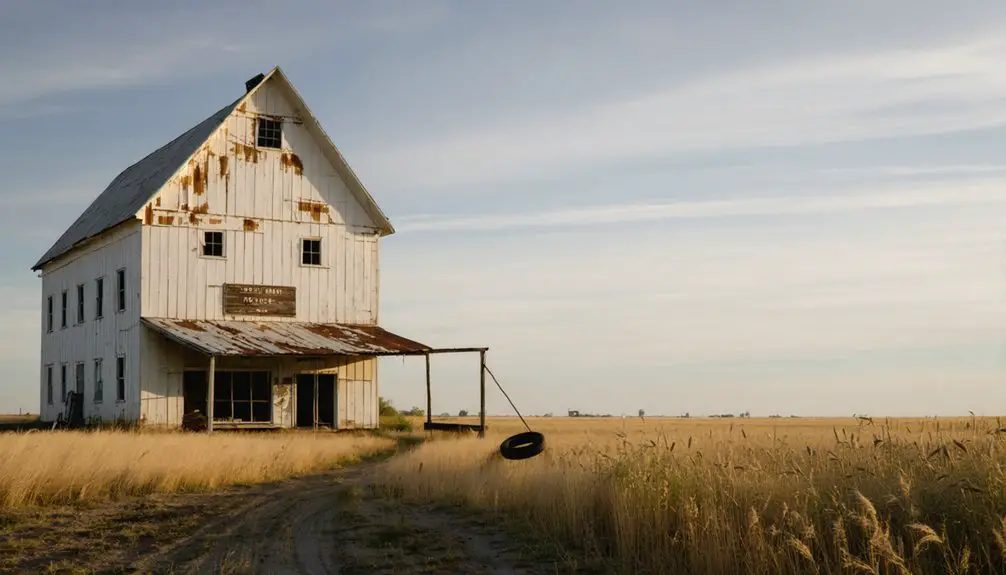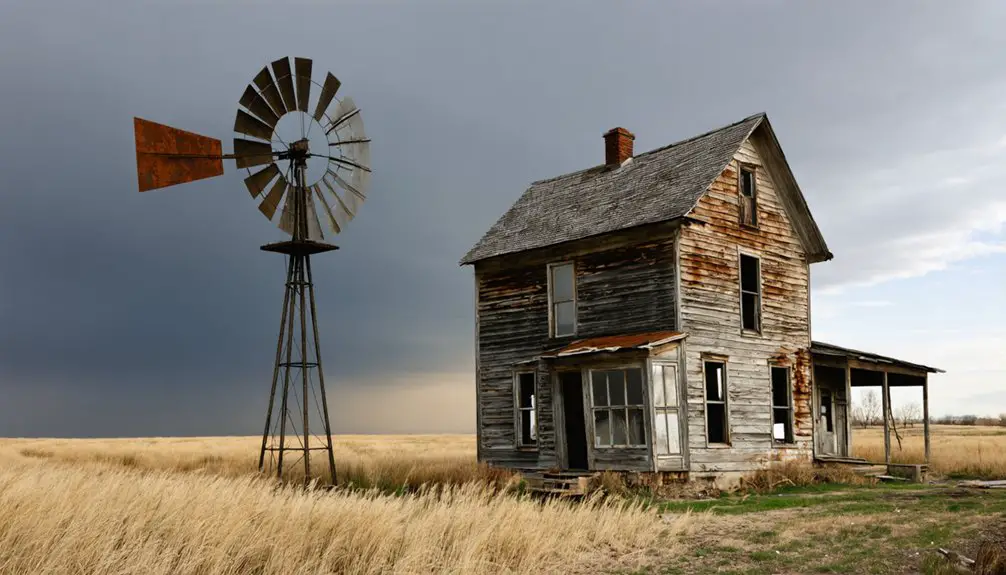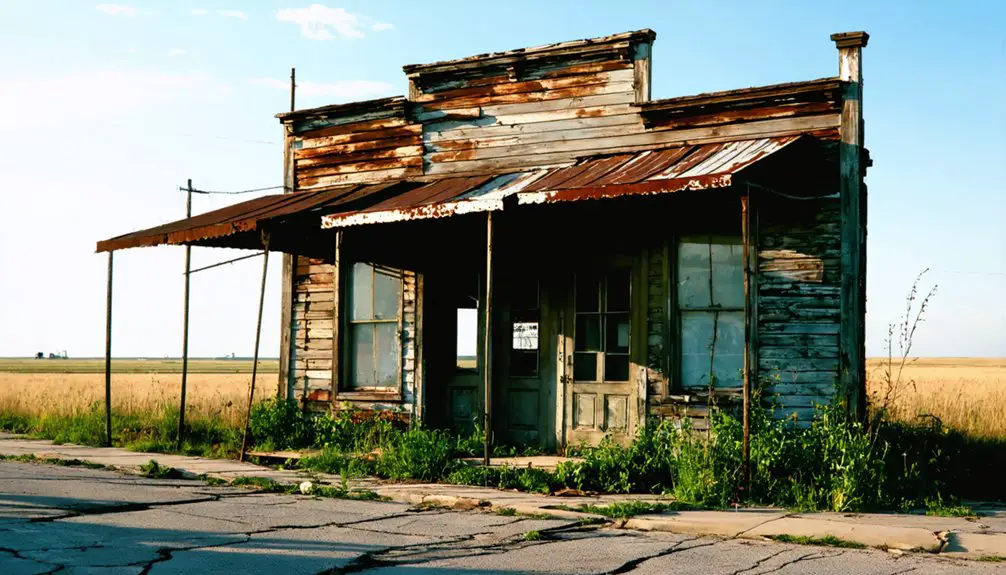You’ll discover Mission Creek’s fascinating transformation from a thriving 1850s Nebraska Territory settlement to a ghost town. The town emerged when pioneers like Bartholomew, Neal, and Musfeldt filed early land claims, eventually supporting up to 30 wagons daily at its peak. Trading posts, churches, and merchant networks flourished until a devastating 1860s land speculation bust triggered its decline. Today, Mission Creek’s rich frontier history lives on through preservation efforts and documented accounts.
Key Takeaways
- Mission Creek settlement began in Nebraska Territory during the 1850s, with George Tanner becoming the first permanent resident in 1859.
- The town served as a bustling river stopover accommodating up to 30 wagons daily and featured trading posts, churches, and stores.
- A catastrophic land speculation bust in the early 1860s caused property values to plummet from $66 per lot.
- The town’s decline accelerated due to rapid population exodus, lack of sustainable industries, and changes in transportation routes.
- Natural disasters, particularly recurring floods between 1881 and 2019, contributed to the town’s eventual abandonment and ghost town status.
The Birth of a Frontier Settlement
As Nebraska Territory opened to settlement in the mid-1850s, Mission Creek emerged from its first recorded land claim by settler Bartholomew in 1856.
You’ll find that settler motivations quickly drew others to file land claims, with David Neal and Henry Musfeldt staking their pieces of the frontier in 1857.
George Tanner made history as the area’s first permanent resident in 1859, building his cabin near what would become Mission Creek Church.
The settlement’s prime location in southwest Pawnee County attracted a steady stream of pioneers seeking opportunity along the frontier river valleys.
Through the 1860s and 1870s, you’d have witnessed the arrival of influential settlers like Abe Manley, Thomas Clark, John Bowhay, and Perry Miller as they transformed the prairie into a patchwork of 40 to 80-acre farms.
The five dollars per acre land price, with generous payment terms, made the area particularly appealing to prospective homesteaders.
Life Along Mission Creek’s Waters
The settlement’s growth alongside Mission Creek shaped daily life for its pioneering residents. You’d find families drawing water from Lake Pokegama’s outflow while facing significant settlement challenges as they carved out homesteads from the densely forested terrain.
The creek’s presence proved crucial, powering the sawmill that processed up to 75,000 feet of lumber daily and employed 100 men. Early settlers endured hardships similar to Table Rock, where a wet season flooding caused widespread suffering and crop damage.
Agricultural practices evolved as settlers tackled the intimidating task of clearing stumps—up to 400 per acre—to create farmable land.
If you’d visited in the 1880s, you’d see 40 to 80-acre plots where determined farmers had transformed forest into fields.
The creek’s waters sustained both the thriving lumber industry and the growing farming community, while providing essential resources for the residents’ daily needs.
Trading Posts and Economic Growth
When pioneers first settled the Mission Creek area, strategic trading posts emerged as essential economic hubs that transformed the region’s commerce. You’d find these posts strategically positioned at river junctions, where they’d establish warehouses, blacksmith shops, and supply depots to serve both Native and settler communities. Similar to Fort William’s cottonwood stockade, many trading posts were fortified structures that provided security while facilitating commerce.
The trading post dynamics centered on fierce economic competition between rival companies vying for dominance in the fur trade. You could witness traders working to secure valuable partnerships with Native communities, who proved to be skilled negotiators in exchanging furs for manufactured goods.
These posts didn’t just facilitate trade – they sparked broader economic growth, stimulating farming, freighting businesses, and infrastructure development. As railroad expansion reached the region, these traditional trading centers had to adapt or fade into history.
Daily Life in a River Town
You’d find Mission Creek’s daily rhythms centered around its position as a bustling river stopover, where up to 30 wagons per day would pause to trade supplies and rest during the 1880s.
The community’s social fabric was woven through regular gatherings at the United Presbyterian Church, completed in 1873, which stood prominently near Halderman’s store at the heart of town. After the Otoe-Missouria removal in 1882, the surrounding farmland saw an influx of new settlers eager to establish roots in the area. Like many frontier towns, they hosted silver cornet band performances that brought entertainment to the local population.
Local fairs held at the town’s fairgrounds between 1876 and 1880 brought together farmers, merchants, and travelers, showcasing agricultural innovations and strengthening community bonds.
Trading at River’s Edge
Along Mission Creek‘s bustling riverbank, trading posts served as essential economic and social hubs where diverse groups converged to exchange goods and services.
You’d find river commerce flowing through these outposts, where trappers brought pelts while Native American tribes traded crafted goods. The trade dynamics shifted with the seasons – winter bringing furs and hides, summer yielding agricultural products from nearby settlers. Similar to the Osage trading post established in 1825, these posts became long-lasting centers of community development.
- Posts offered crucial blacksmith services for wagon repairs and farm tools, keeping the wheels of commerce turning.
- Merchants stocked European goods like glass beads and metal tools, creating a bridge between eastern markets and frontier needs.
- Trading relationships fostered complex cultural exchanges between settlers and indigenous peoples, building networks that shaped local economies.
Community Social Gatherings
Beyond the bustling trade activities, Mission Creek’s social heart beat strongest at the stone store near Holderman’s corner. You’d find the community gathering in the hall above for oyster suppers, parties, and even casting votes during elections.
From 1876 to 1880, the fairground across the road hosted the official Pawnee County Fair, where you could witness remarkable community events like pony races with Native American riders and demonstrations of local inventions.
The town’s social bonding wasn’t limited to celebrations. When seasonal floods and disease outbreaks challenged settlers, these gatherings provided essential support.
Doctors maintained practices at prominent corners, while stores doubled as post offices, weaving commerce and civic life together in this resilient prairie community. The United Presbyterian Church became a cornerstone of community life, with regular Sunday-school sessions bringing families together.
Notable Residents and Their Stories

While Mission Creek’s early traders pioneered commerce along the riverbanks, you’ll find Joseph Deroin’s legacy particularly significant as he established one of the first successful trading posts serving both settlers and Native Americans.
The steamboat traffic along the Missouri River in the 1840s brought increased trade opportunities to the area.
You can trace the economic foundations laid by merchant families like the Browns and Langdons who brought essential supplies and services to this frontier community.
These pioneering merchants and traders formed Mission Creek’s commercial backbone, connecting the isolated settlement to broader trade networks and fostering its initial growth. Deroin’s influence extended beyond Mission Creek until his life tragically ended when he was shot in 1858.
Early Traders and Merchants
Throughout Mission Creek’s early development, several influential traders and merchants played pivotal roles in establishing the region’s economic foundation. You’ll find C.W. Giddings at the forefront of these trading dynamics, initiating the first freighting business from Mission Creek to Fort Kearney in 1859. Like the successful traders in St. Louis and Franklin, Mission Creek merchants established profitable supply networks across the region.
Local merchant networks expanded rapidly, connecting Mission Creek to established routes like the Santa Fe Trail while providing essential services to travelers and settlers.
- Merchants transformed from fur traders to versatile suppliers, offering wagons, provisions, and repair services to meet the evolving needs of pioneers.
- The shift from fur trading to farming and freighting marked Mission Creek’s adaptation to changing economic landscapes.
- Local traders created crucial connections between Native American communities and American settlers, facilitating cultural and economic exchange.
Mission Creek’s Pioneer Families
As Mission Creek took shape in the mid-19th century, its pioneer families established a richly diverse community that blended French-American and Native American heritage. Notable residents like Joseph Deroin, born to a French trapper and Otoe woman, exemplified this cultural fusion while operating influential trading posts that strengthened the settlement’s economic foundation.
Pioneer heritage ran deep through Mission Creek’s family dynamics, with settlers working together to build homes, churches, and schools.
You’ll find stories of determined homesteaders who faced environmental challenges like floods and prairie fires, yet persevered through communal support. Families joined forces during barn raisings and harvests, while maintaining strong religious ties through Methodist and Catholic missions.
Their shared experiences at social gatherings and harvest festivals fostered lasting bonds that shaped Mission Creek’s identity.
Natural Disasters and Setbacks
Since its establishment, Mission Creek has endured numerous natural disasters that have shaped its decline, with flooding emerging as the most persistent threat.
You’ll find flood impacts documented across major events in 1881, 1952, 1993, 2011, and 2019, when severe flooding damaged infrastructure and inundated farmland.
The area’s vulnerability extends beyond flooding – the Mission Creek watershed faces significant wildfire risks due to decades of fuel accumulation since the last major fire in 1964.
- Post-fire erosion could increase by 385% during typical storms, potentially overwhelming the creek’s capacity
- Sediment buildup of just one foot reduces water flow by 10%, magnifying flood dangers
- Historic levee failures and overtopping events highlight the ongoing struggle to protect settled areas
The Town’s Slow Decline
While Mission Creek initially showed promise as a bustling frontier settlement, the town’s decline stemmed from a catastrophic speculative land bust in the early 1860s.
Land prices that once averaged $66 per lot plummeted within two years as investors frantically sold their holdings at fire-sale prices, triggering an economic collapse that would prove irreversible.
You’d have witnessed a rapid exodus of residents as employment opportunities vanished and essential services shut down.
The lack of sustainable local industries, combined with possible changes in transportation routes and withdrawn governmental support, accelerated the population migration.
Without a stable economic foundation or reliable infrastructure, Mission Creek couldn’t retain its remaining inhabitants.
The town’s dependence on speculative real estate, rather than diversified commerce, ultimately sealed its fate as another Nebraska ghost town.
Preserving Mission Creek’s Memory
The story of Mission Creek lives on through dedicated preservation efforts that span both physical and digital domains.
Historical documentation projects capture memories through photographs, oral histories, and archival records, while community engagement initiatives bring these stories to life. You’ll find volunteer groups maintaining the site, organizing public events, and creating educational programs that connect past with present.
Digital preservation tools now let you explore Mission Creek’s history through virtual tours and interactive exhibits.
- Local historical societies work with university experts to validate and preserve authentic accounts of Mission Creek’s legacy.
- Community-driven storytelling sessions and reunions keep the town’s memory alive through firsthand experiences.
- Modern technology enables broader access to Mission Creek’s history through virtual tours and augmented reality experiences.
What Remains Today
Modern visitors to Mission Creek ghost town will find nature has largely reclaimed this once-bustling settlement, with few physical remnants of its pioneer past remaining visible.
You’ll discover most structures have crumbled, leaving only foundational outlines amid the prairie grasses and shrubs that now dominate the landscape.
During ghost town exploration, you might encounter scattered artifacts like old tools, pottery shards, and building materials that hint at the site’s history.
Archaeological findings occasionally surface after rain or erosion, though no formal excavations are currently underway.
The surrounding environment offers glimpses of what drew settlers here – gently rolling terrain and flowing creeks.
While accessing the site can be challenging due to unmaintained roads, you’ll share the space with abundant wildlife that now calls this forgotten settlement home.
Frequently Asked Questions
Were Any Native American Artifacts Found in Mission Creek’s Vicinity?
You’ll find numerous Native artifacts and archaeological findings along Mission Creek, including arrowheads from 1960s plowing and items from Woodland and Archaic periods discovered during 1978’s scientific excavation.
What Role Did Mission Creek Play During the Civil War?
Like a quiet sentinel along the Missouri River, you’ll find no major Civil War battles here, though its strategic location near Fort Kearney supported troop movements and supply lines.
Did Mission Creek Have Connections to the Underground Railroad?
You’ll find significant underground connections existed here, as historical records show this station served on a Lane Trail spur, linking to Nebraska City’s network and helping freedom seekers escape north during 1857-1860.
Were There Any Documented Paranormal Activities in Mission Creek?
Like smoke that fades in daylight, you’ll find no verified ghost sightings or spectral apparitions in Mission Creek’s records, though local folklore includes unsubstantiated claims of chain-rattling and mysterious screams.
What Happened to Mission Creek’s Cemetery and Burial Records?
You’ll find the cemetery’s still maintained by a local association, with burial records documenting interments from the 1870s onward, though some older markers and documentation have weathered away over time.
References
- https://www.nebraskalife.com/blog/post/saint-deroin-ghost-town
- https://visitnebraska.com/trip-idea/explore-7-authentic-ghost-towns-nebraska
- https://www.americanheritage.com/ghost-town-river
- https://www.youtube.com/watch?v=redtU6GT-BY
- https://dakotacounty.ne.gov/pdfs/clerk/history.pdf
- https://history.nebraska.gov/wp-content/uploads/2017/12/doc_publications_NH1961MissouriRFrontier.pdf
- https://en.wikipedia.org/wiki/History_of_Nebraska
- https://www.familysearch.org/en/wiki/Pawnee_County
- https://www.upperbigblue.org/sites/default/files/resource-files/old-settlers-early-history-york-co.pdf
- http://www.kancoll.org/books/andreas_ne/pawnee/pawnee-p3.html



